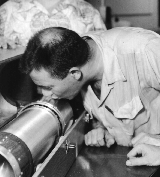|
The trapping of particles by magnetic fields was first studied by Kristian Birkeland in Norway, starting around 1895. Birkeland aimed beams of electrons (called "cathode rays" in those days) at a magnetized sphere or "terrella" inside a vacuum chamber, and noted that they seemed to be channeled towards the magnetic poles. He then asked his former teacher, the renowned French mathematician Henri Poincare, to examine their motion. Poincare managed to solve the motion of charged particles near an isolated magnetic pole, showing that they spiraled around field lines and that they were repelled from regions of strong field.
Stoermer's Calculations
An isolated magnetic pole is a mathematical abstraction. A more realistic problem, of more interest to Birkeland, was particle motion near a compact bar magnet or "dipole", which better approximated the field of the Earth or of his terrella. He suggested the problem to a friend, the mathematician Carl Stoermer, who devoted to it an appreciable part of his career. Stoemer never found a full solution, a formula which would predict the particle's motion to all time, like the formula for the motion of a single planet around an isolated sun. In fact, none exists in conventional mathematical terms, because the motion is inherently intricate (today's buzz-word is "chaos", an area pioneered by Poincare). But he did show that large families of orbits would remain trapped forever.
The orbits Stoermer was most concerned with belonged to particles with rather high energies. In general they did not resemble tidy spirals, because they covered large sections of the magnetic field, and in the course of each excursion around the field, the intensity and direction of the magnetic field did not stay the same but varied appreciably. Later, when cosmic rays were discovered, it turned out that Stoermer's theory applied quite well to their motion: but it did not solve the mystery of the polar aurora, as Stoermer had hoped.
Scientists in those days also wondered whether trapped particles were the cause of the mysterious "ring current" responsible for magnetic storms, but it was hard to imagine a process which created enough ions or electrons of cosmic ray energies to sustain them. Only in 1957 did S. Fred Singer (U. of Maryland) propose that the ring current may be carried by particles of much lower energies, injected somehow into trapped orbits during magnetic storms. In the following year the radiation belt was discovered--existing all the time, not just during storms--and gradually the details fell into place.
Meanwhile in the 1950s efforts began to confine plasma in laboratory magnetic fields for producing controlled nuclear fusion, and in the process the theory of trapped particles was greatly developed and expanded.
Project Argus
Perhaps the most interesting story of that era concerns Nicholas Christofilos, a Greek elevator engineer whose avocation was the study of particle motion in magnetic fields. Pursuing those studies he discovered "strong focusing," now a widely-used method of controlling beams of energetic ions in accelerators, and he communicated this to scientists in the US, but received little attention until the principle was independently re-discovered. He then came to the US and worked for the rest of his career on various aspects of magnetic trapping of particles, in particular the trapping of plasma in devices intended to release fusion energy (see plasma).
As a grand experiment he proposed in October 1957 to the US Air Force to launch rockets with small atomic bombs, and detonate them in space: atomic bombs produce large numbers of energetic electrons, and Christofilos hoped that such electrons would become trapped in the magnetic field as an artificial radiation belt.
That project, conducted in secrecy and code-named Argus, received a great boost when Van Allen's Explorers 1 and 3 discovered the natural radiation belt, and it was carried out above the Southern Atlantic in August and September 1958. Three bombs were exploded outside the atmosphere, above a deserted stretch of ocean, and the public only learned about it the following year, when many related scientific studies were published.
|

 Official GSFC Home Page
Official GSFC Home Page  NASA WWW Home Page
NASA WWW Home Page